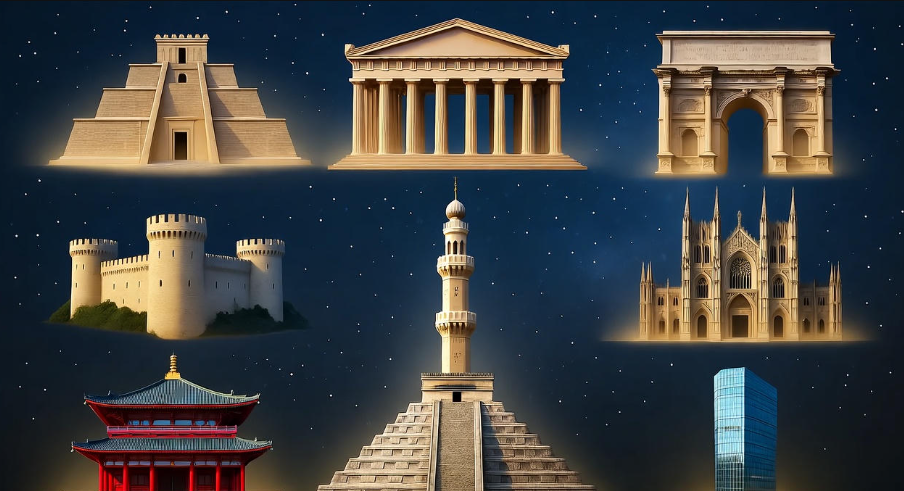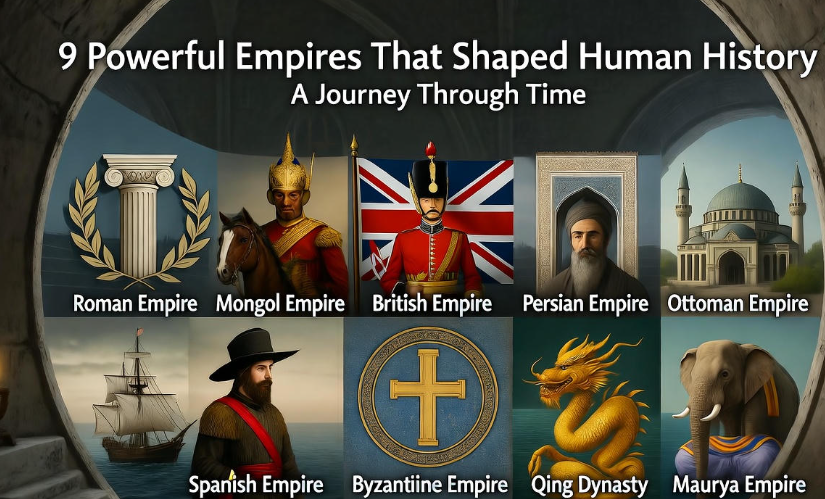Throughout human history, certain empires have left such a strong mark on the world that their influence can still be seen today — in our languages, cultures, architecture, and even the way we think. These were not just powerful kingdoms with armies and rulers; they were centers of innovation, trade, philosophy, and art. 🌍✨
Let’s travel back in time and explore 9 powerful empires that truly shaped human civilization in ways we still feel today.
1. The Roman Empire 🇮🇹
The Roman Empire was one of the most influential forces in history. At its height, it stretched across Europe, North Africa, and the Middle East. What made Rome so unique wasn’t just its military power — it was its organization, its roads, its laws, and its culture that shaped Western civilization.
Romans built advanced systems like aqueducts for water supply, massive amphitheaters for entertainment, and roads that connected cities thousands of miles apart. Even today, many modern governments base their legal systems on Roman law principles.
One fascinating fact is that Latin, the Roman language, gave birth to modern languages like Italian, Spanish, and French. So in a way, the Romans still “speak” through us every day!
| Legacy of Rome | Impact on Modern World |
|---|---|
| Roman Law | Inspired modern legal systems |
| Engineering | Roads, aqueducts, architecture |
| Language | Foundation for Romance languages |
| Government | Early model for republic systems |
2. The British Empire 🇬🇧
At one point, the British Empire was so vast that people said, “The sun never sets on the British Empire.” It ruled over nearly a quarter of the Earth’s population — from India and Africa to Canada and Australia. 🌏
The British spread the English language, introduced railways, and helped establish global trade routes that still exist today. But it wasn’t just about control; the empire influenced literature, law, education, and democracy around the world.
However, its legacy is complex — while it brought modernization, it also led to colonization and cultural exploitation. Today, more than 50 countries are part of the Commonwealth, keeping cultural ties alive even after independence.
3. The Mongol Empire 🐎
If there’s one empire that reshaped the map faster than anyone else, it was the Mongol Empire, led by the legendary Genghis Khan. In less than 25 years, the Mongols built the largest continuous land empire in history.
Their secret? Discipline, mobility, and innovation. The Mongol army could move faster and fight harder than anyone else. But the Mongols were not just warriors — they were brilliant organizers. They connected the East and West through trade routes like the Silk Road, encouraging cultural and economic exchange between Europe and Asia.
Fun fact: Genghis Khan’s descendants ruled parts of China, Persia, and even Russia. His DNA can still be found in millions of men today! 😲
4. The Ottoman Empire 🕌
The Ottoman Empire lasted over 600 years, ruling parts of Europe, Asia, and Africa. It was known for its tolerance, architecture, and diverse population. The Ottomans allowed different religions to coexist under one rule, which was quite rare for the time.
Their capital, Istanbul (then Constantinople), became one of the greatest cities in the world — a crossroads of trade and culture. Ottoman art, music, and architecture (like the Blue Mosque) continue to inspire people today.
They also played a key role in global trade routes connecting Asia and Europe. Eventually, the empire declined in the early 20th century, giving rise to the modern nation of Turkey.
| Ottoman Achievements | Description |
|---|---|
| Architecture | Magnificent mosques and palaces |
| Culture | Blended European, Arab, and Persian styles |
| Administration | Strong centralized government |
| Religion | Promoted coexistence among diverse faiths |
5. The Ancient Egyptian Empire 🏺
When you think of pyramids, mummies, and pharaohs — you’re thinking of one of the most iconic civilizations ever: Ancient Egypt.
Egyptians were pioneers in mathematics, medicine, and engineering. The construction of the Great Pyramids of Giza still amazes scientists today. Their writing system, hieroglyphics, was one of the earliest forms of written language.
They also believed in the afterlife, which shaped their art and culture for thousands of years. The pharaohs were not just rulers — they were seen as gods on Earth.
Even after thousands of years, Egypt’s art, architecture, and symbols continue to fascinate the world. 🌞
6. The Persian Empire (Achaemenid Empire) 🏛️
The Persian Empire, founded by Cyrus the Great, was one of the first empires to practice tolerance and respect for different cultures. It stretched from India to Greece and had one of the most advanced administrations of its time.
Persians built the famous Royal Road, allowing messages and goods to travel thousands of kilometers quickly — a bit like an ancient postal system! They also introduced the concept of satraps (governors) to manage vast territories efficiently.
Their ideas about fairness, governance, and infrastructure deeply influenced later empires, including the Greeks and Romans.
7. The Chinese Empire (Han Dynasty & Ming Dynasty) 🐉
China’s long history of empire is full of remarkable innovation. The Han Dynasty established the civil service system and opened up the Silk Road, which connected China to Europe.
Later, during the Ming Dynasty, China became a global powerhouse in trade, technology, and art. They built much of the Great Wall, advanced shipbuilding, and even produced the world’s first paper money.
Chinese inventions like gunpowder, paper, and the compass completely transformed the world. Even today, Confucian philosophy and Chinese culture continue to influence millions around the globe.
8. The Greek Empire 🇬🇷
The Greeks didn’t build the largest empire — but they built one of the most intelligent ones. Their influence on philosophy, science, art, and politics is unmatched.
Think of names like Socrates, Plato, and Aristotle — they shaped the very idea of thinking and reasoning. The Greeks also invented democracy, giving people the power to choose their leaders — an idea that continues to define modern politics.
Under Alexander the Great, Greek culture spread across Asia, blending with local traditions to create what historians call the Hellenistic Civilization. From architecture to literature, the Greek spirit of curiosity and creativity shaped the modern world. 🏛️
9. The Islamic Caliphates 🌙
After the 7th century, the Islamic Caliphates (especially the Abbasid and Umayyad Caliphates) transformed the world through knowledge, science, and culture.
While Europe was going through its Dark Ages, cities like Baghdad, Damascus, and Córdoba became centers of learning. Scholars translated Greek and Roman texts, made breakthroughs in astronomy, medicine, mathematics, and philosophy.
They invented algebra, advanced surgery, and built magnificent architecture like the Alhambra and the Dome of the Rock. The Islamic world became a bridge between ancient wisdom and modern science.
| Field | Muslim Contribution |
|---|---|
| Science | Algebra, astronomy, optics |
| Medicine | Hospitals, surgical tools |
| Architecture | Domes, mosaics, calligraphy |
| Literature | Poetry, philosophy, translation works |
How These Empires Still Shape Our World 🌎
All these empires had one thing in common — they connected humanity. They spread language, ideas, inventions, and culture. Many modern institutions — from universities to parliaments — have roots in these ancient powers.
Our art, food, technology, and even beliefs carry small traces of them. So, in a sense, every time we use paper, quote a philosopher, or admire a building, we are honoring their legacy.

Quick Summary Table
| Empire | Key Strength | Major Influence |
|---|---|---|
| Roman Empire | Law & Engineering | Western civilization |
| British Empire | Global Trade | English language, democracy |
| Mongol Empire | Warfare & Unity | Global connectivity |
| Ottoman Empire | Culture & Architecture | Middle East and Europe |
| Egyptian Empire | Science & Religion | Art, architecture |
| Persian Empire | Governance | Administration systems |
| Chinese Empire | Innovation | Technology, philosophy |
| Greek Empire | Philosophy | Democracy, science |
| Islamic Caliphates | Knowledge | Medicine, mathematics |
FAQs 🧐
Q1: Which empire was the largest in history?
The Mongol Empire was the largest continuous land empire ever, stretching from East Asia to Europe.
Q2: Which empire lasted the longest?
The Roman Empire (including Byzantium) and the Ottoman Empire both lasted for centuries — the Ottomans for over 600 years.
Q3: How did these empires shape modern life?
They influenced law, language, science, trade, and government systems that are still in use today.
Q4: Which empire contributed most to science?
The Islamic Caliphates made groundbreaking discoveries in medicine, mathematics, and astronomy that later inspired the European Renaissance.
Q5: What is the common factor among all great empires?
Each of them encouraged innovation, trade, and the exchange of ideas — even if their goals were different.
Empires rise and fall, but their ideas never die. From the wisdom of the Greeks to the discipline of the Romans, from the innovation of the Chinese to the global reach of the British — these legacies continue to guide humanity’s journey forward. 🌏💫

Leave a Reply